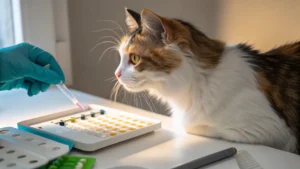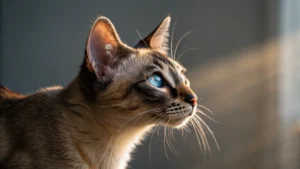Ever seen a cat that looks like it was painted by two artists? Picture a cat with a face split down the middle, showing two different colors. These rare cat breeds, known as chimera cats, are real and amazing.
This Breed Of Cats are a rare genetic wonder. They have a unique coat pattern that’s unlike any other cat. Their split-colored look is a result of their special genetic makeup.
What’s fascinating about this rare cats is their genetic uniqueness. They come from a rare process where cells fuse early in their development. This creates their stunning and unusual look, captivating cat lovers everywhere.
Understanding the Fascinating World of Chimera Cats
This Breed Of Cats are a rare wonder in the world of cats. They have a unique genetic condition that makes them stand out. These cats have special physical traits that make them truly unique.
Chimerism in animals is when an organism has two or more different sets of genes. In cats, this leads to amazing looks that make them different from others.
👉 What Makes a Cat a True Chimera
A true chimera breed cat comes from a special process in early development. To be a true chimera, a cat must have:
- Distinct color patterns on different body parts
- Genetically different cell populations within a single organism
- Evidence of merged embryos during early development
👉 The Science Behind Feline Chimerism
The genetics of chimera breed cats involve complex cell interactions. When two fertilized eggs merge early on, a single cat with two genetic profiles is formed. This results in extraordinary visual manifestations that amaze both scientists and cat lovers.
👉 Natural Occurrence vs. Genetic Anomaly
This Rare Cat are very rare but are a natural genetic variation. Scientists believe they are found in very low numbers in cats. This makes them a fascinating topic for study.
This Breed Of Cats show the amazing complexity of genetics and cell development in animals.
The Genetic Mystery of Two-Faced Cats
Seeing a two-faced cat might make you wonder if it’s just an illusion. These cats, known as chimera cats, have a unique look. Their appearance comes from a rare genetic mutation.
The science behind these cats is both complex and fascinating. Researchers found that these cats come from a rare process. Two embryos merge early in development, creating a single cat with two genetic profiles.
- Genetic mutations occur during early embryonic stages
- Cell fusion creates a unique genetic blueprint
- Each side of the cat can have different genetic information
“Nature’s genetic variations can produce some of the most stunning and unexpected results,” says Dr. Sarah Thompson, a feline geneticist.
Understanding two-faced cats is more than just being amazed by their looks. The genetic mutation that causes their split appearance is rare. Scientists are still learning about these cats to understand genetic chimerism better.
Though rare, these cats show the amazing complexity of genetics. Each two-faced cat has its own genetic story. They are true wonders of nature.
How Chimera Breed Cats Get Their Split-Colored Faces
Split-faced cats are a fascinating genetic phenomenon. They have unique cat markings that make them stand out. This happens through a special biological process that starts early in their development.
This Rare Cats get their look from a rare genetic event. This event is called cellular mosaicism. It happens when two embryos merge into one during early development.
👉 The Cellular Fusion Process
Something amazing happens early in their growth. Two embryos merge, creating a single organism with two genetic profiles. This fusion gives the split-faced cat its incredible look.
- Embryos merge before cell differentiation
- Genetic material from two distinct sources combines
- Each cell retains its original genetic information
👉 Color Distribution Patterns
The unique markings of a chimera cat come from how the merged cells spread across the body. The face shows the most striking color difference, making it look like two cats in one.
Genetic researchers are still learning about these cats. They study how the fusion of cells leads to such amazing genetic variations. Each split-faced cat shows the amazing complexity of genetic development.
Distinguishing Between Chimera Cats and Regular Bi-Colored Cats
Not every cat with two colors is a true chimera. These special cats might look alike at first, but they have key differences. Knowing these can help spot a real chimera cat.
This Rare Cats have a special genetic mix that makes them stand out. Unlike regular bi-colored cats, their unique look comes from a rare cell fusion early in development. This means their split-colored face is more than just a surface mark; it’s a deep genetic trait.
- True This Breed Of cats typically have:
- Perfectly split facial coloration
- Potentially different eye colors
- Unique genetic composition from cell fusion
- Regular bi-colored cats feature:
- Standard coat color patterns
- Uniform genetic inheritance
- Predictable color distributions
To really know if a cat is a chimera, you need genetic tests. Just looking at them isn’t enough. Vets can do DNA tests to see if a cat is truly a chimera or just has cool markings.
Remember, not all cats with interesting color patterns are chimeras – genetic verification is key!
When you see a cat that might be a chimera, look for special signs. Their amazing look is not just for show. It tells a deep story of biology.
The Rarity Factor: Why This Type Of Cats Are Uncommon
This cats are a rare wonder in the world of cats. They are very rare, making them a genetic marvel. To understand their rarity, we must explore the complex world of cellular fusion and genetics.
This Type Of Cats are very rare. Experts say they make up less than 0.1% of all cats. This rare condition happens when two embryos merge early in development. This creates a cat with two different genetic profiles.
👉 Statistical Insights into Chimera Cats
- Less than 0.1% of cats exhibit true chimera characteristics
- Most This Types Of cats are discovered accidentally
- Genetic testing is required to confirm genuine chimerism
👉 Breeding and Inheritance Challenges
Chimera Breeding cats on purpose is very hard. The chance of two embryos merging is random. This makes it hard to predict when a chimera cat will be born.
Nature’s genetic lottery creates these extraordinary felines through an unpredictable and rare process.
Veterinary geneticists are studying these cats. They want to understand their unique genetics. While breeding them is hard, scientists are still very interested in these cats.
Famous Chimera Cats That Captured Internet Fame
The internet has fallen in love with some truly remarkable split-faced cats. These cats show the incredible genetic wonder of chimera cats. They have become viral sensations, winning the hearts of millions with their unique looks.
One of the most famous chimera cats is Venus. She has a half-black, half-orange face that looks perfectly divided down the middle. Her striking appearance made her an instant internet celebrity, drawing attention to the fascinating world of chimera cats.
- Venus: The most recognized split-faced cat online
- Narnia: Another popular chimera cat with stunning genetic traits
- Social media platforms that helped showcase these unique felines
These remarkable chimera cats have done more than just entertain. They’ve sparked scientific curiosity and raised awareness about genetic variations in cats. People worldwide have become fascinated by the intricate genetic processes that create such mesmerizing feline appearances.
The beauty of chimera cats lies in their unique genetic makeup, telling a story of cellular fusion that’s written across their faces.
While not every split-faced cat is a true chimera, these internet sensations have brought unprecedented attention to this rare genetic phenomenon. They’ve transformed from simple pets to global ambassadors of feline genetic complexity.
Photographers, geneticists, and cat lovers alike continue to be captivated by these extraordinary animals. Their popularity proves that nature’s genetic mysteries can be both scientifically fascinating and visually stunning.
Identifying Physical Characteristics of Chimera Cats
This Type Of cats are known for their unique looks. They have split-colored faces and special markings. These features make them stand out to cat lovers.
Exploring the physical traits of these cats is fascinating. They have features that make them truly special.
👉 Distinctive Facial Features
The most striking feature of chimera cats is their split facial coloration. This creates a visual divide down the center of their face. It’s like two cats in one.
- Perfectly symmetrical color division
- Sharp line of demarcation between colors
- Dramatic contrast in fur coloration
👉 Eye Color Variations
This Rare Cat have unique eye colors. They often have heterochromia, where each eye is a different color. You might see:
- Blue and green
- Gold and blue
- Green and amber
“Nature’s palette is most vibrant in these extraordinary felines” – Feline Genetics Research Institute
👉 Coat Pattern Analysis
This Unique Cat have coat patterns as unique as fingerprints. Their fur can be split-colored, have patches, and unexpected color combinations. It’s like they defy genetic logic.
Understanding these traits helps us appreciate the genetic marvel of chimera cats. They show the incredible complexity of feline genetics.
The Scientific Process of Confirming True Chimerism
To find a true chimera cat, experts use special genetic tests. These tests are more than just looking at the cat. They use advanced science to check if a cat is a chimera.
The steps to confirm a chimera cat are important:
- Collecting DNA samples from different body regions
- Performing genetic marker analysis
- Comparing cellular genetic profiles
Vets take DNA samples from various places:
- Skin cells
- Blood samples
- Hair follicles
- Cheek swabs
The best way to check is DNA microsatellite testing. It shows genetic differences in different body parts. This test can find different genetic profiles in one cat, proving it’s a true chimera.
Genetic testing is the only sure way to tell if a cat is really a chimera or just has cool coat patterns.
Lab experts use high-tech sequencing to study these samples. They look for genetic signs that show cell fusion in early development. This is what makes a cat a true chimera.
Learning about feline genetics helps scientists understand chimera cats. It’s a mystery that interests both scientists and cat lovers.
Health and Lifespan of Chimera Cats
This Unique Cat are rare and fascinating. They have unique health needs that owners should know. These cats usually live as long as other domestic cats. There’s no special health problem linked to being a chimera.
Vets say chimera cats face no more health issues than regular cats. Their special genes don’t mean they’re more likely to get sick.
👉 Medical Considerations for Chimera Breed Cats
Looking after a chimera cat means focusing on a few important health points:
- Regular vet visits
- Standard shots
- Watching for age-related problems
- Genetic tests if needed
👉 Special Care Requirements
This Unique Cat don’t need special care, but a few things can help them stay healthy:
- Feed them a balanced diet based on their age and size
- Keep them mentally and physically active
- Have them checked by a vet every year
- Look out for any odd physical or behavior changes
With the right care, your chimera rare cat can live a happy, healthy life. Understanding their unique genetic makeup is key.
Myths and Misconceptions About Cat Chimera
Chimera often spark wild imagination and misconceptions. Many people believe these unique two-faced cats have supernatural abilities or drastically different personalities. But the truth is much more scientific and fascinating.
Let’s debunk some common myths about chimera animals:
- Myth: Two-faced cats have split personalities
- Myth:Cat Chimera are always sterile
- Myth: Every cat with different colored fur is a chimera
- Myth: Chimera breed cats have major health problems
Genetic experts say chimera cats are just the result of fascinating cellular fusion during early development. Their unique look doesn’t mean they have magical powers or serious health issues.
The biggest myth is that all cats with distinct facial markings are chimeras. But true chimera cats come from rare genetic events where two embryos merge. This means not every bi-colored cat is a true chimera.
Understanding chimera cats requires scientific insight, not mystical thinking.
Your interest in these rare felines should be about their real genetic marvel, not myths. Scientific research keeps exploring the world of chimera animals, showing us more about these amazing creatures.
Caring for a Chimera Cat: Essential Tips
Owning a chimera breed cat is a special joy for pet lovers. These cats have unique markings that need special care. Knowing their specific needs helps you give them the best care.
When grooming your cat chimera, consider their coat pattern. Their markings might need gentle brushing to avoid matting. Regular vet visits are also key to watch for any health issues.
- Brush your chimera breed cat’s coat 2-3 times weekly
- Provide a balanced diet specific to their age and health needs
- Create engaging play environments with interactive toys
- Schedule annual genetic health screenings
Good nutrition is vital for your chimera breed cat’s health. Choose high-quality cat food that fits their genetic needs. Playing with them keeps their mind and body active, preventing stress.
Creating a safe and interesting environment is crucial. Give them scratching posts, climbing trees, and window perches. Their unique look might draw attention, so make sure they have a safe place to hide.
Remember, every Cat chimera is an extraordinary individual deserving of love, care, and understanding.
Conclusion
Chimera cats are truly amazing in the world of cats. They have stunning split-colored faces and a unique genetic makeup. Learning about them shows us how complex genetics and cell development are.
Even though chimera cats are rare, they are loving pets just like any other. Their special look comes from a rare genetic process. This makes each one unique. Knowing about chimera cats helps us see the amazing diversity in cat genetics.
If you’re interested in these cats, you’re in good company. They show us that nature is full of surprises. Seeing a chimera cat or looking at their pictures gives us a peek into the magical world of genetics.
We encourage you to keep exploring rare cat breeds and genetic mysteries. Share your stories, ask questions, and learn more about these amazing creatures. They challenge our understanding of genetics and biology.
FAQ
What exactly is a chimera cat?
This Cat is a rare feline with a unique genetic condition. It happens when two embryos merge early in development. This creates a cat with two distinct sets of DNA.
As a result, the cat can have dramatically different colors or patterns on each side of its face. It often looks like two cats fused into one.
How rare are chimera cats?
Chimera cats are extremely rare. Experts say they make up a very small percentage of cats. This makes them a rare genetic phenomenon.
Can This Rare Cat Chimera have different colored eyes?
Yes, chimera cats often have heterochromia, or different colored eyes. This is because their unique genetic makeup can affect eye pigmentation differently on each side of their face.
Are chimera cats a specific breed?
No, chimera cats are not a specific breed. Chimerism can happen in any cat, regardless of breed. It’s a random genetic occurrence.
How can you confirm if a cat is a true chimera?
To confirm if a cat is a true chimera, you need genetic testing. Some cats may look like chimeras due to unique markings. But only DNA testing can prove it by showing two distinct genetic profiles.
Do chimera cats have any special health concerns?
Generally, chimera cats don’t have health issues related to their genetic condition. They usually live normal, healthy lives. But, regular vet check-ups are always a good idea.
Can chimera breed cats be intentionally bred?
Chimera cats can’t be intentionally bred with certainty. The condition is a rare genetic accident. It can’t be reliably reproduced through selective breeding.
Are chimera cats more expensive?
While their unique appearance might attract attention, chimera cats aren’t typically more expensive. Their value depends on individual characteristics, breed, and health, not the chimera condition itself.
How common is chimerism in other animals?
Chimerism is rare in animals, including cats, dogs, and humans. But it’s striking and visually apparent in cats because of their coat color variations.
Do chimera cats have different personalities?
There’s no scientific evidence that chimera cats have different personalities. Their temperament is influenced by breed, socialization, and individual experience, just like any other cat.



